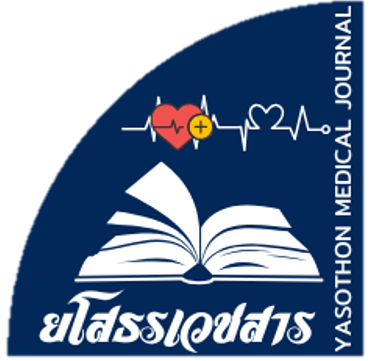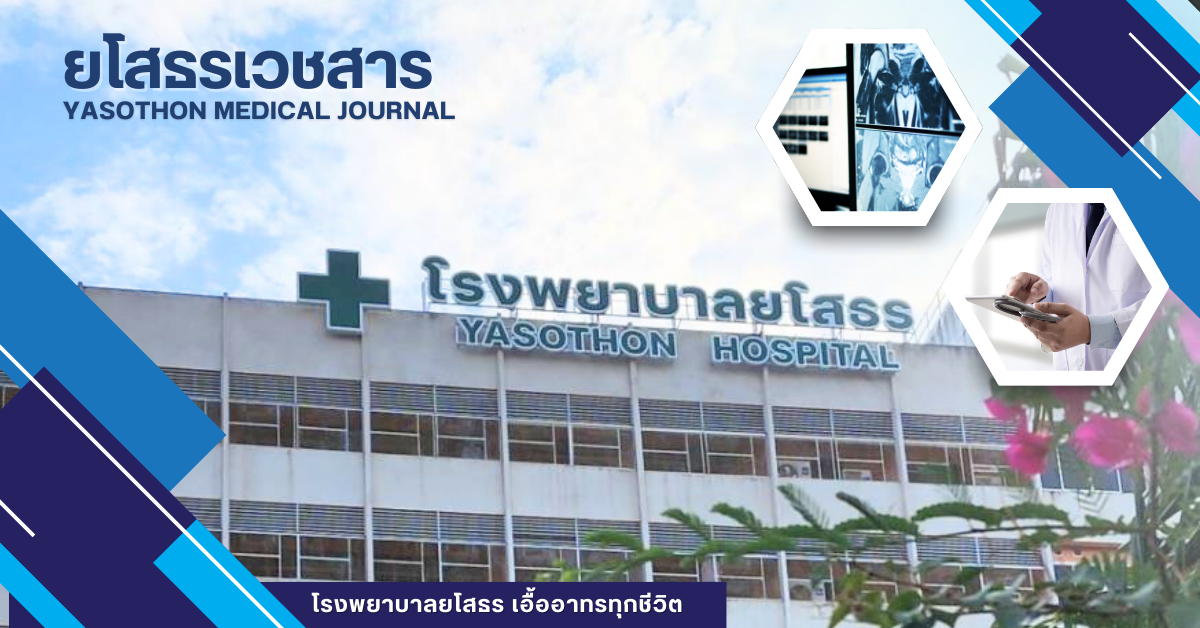ปัจจัยที่มีผลต่อการเกิดเลือดออกในสมองหลังการให้ยาละลายลิ่มเลือดทางหลอดเลือดดำ ในผู้ป่วยโรคหลอดเลือดสมองตีบหรืออุดตันเฉียบพลันที่มารับบริการที่โรงพยาบาลยโสธร
คำสำคัญ:
หลอดเลือดสมองตีบหรืออุดตันเฉียบพลัน, ยาละลายลิ่มเลือด, เลือดออกในสมองบทคัดย่อ
หลักการและเหตุผล: การให้ยาละลายลิ่มเลือดทางหลอดเลือดดำในผู้ป่วยโรคหลอดเลือดสมองตีบหรืออุดตันเฉียบพลัน ถือเป็นการรักษาที่มีประสิทธิภาพแต่หลังการให้ยาสามารถเกิดภาวะแทรกซ้อนที่สำคัญได้คือ ภาวะเลือดออกในสมองรุนแรง การหาปัจจัยที่สัมพันธ์กับการเกิดภาวะเลือดออกในสมองในผู้ป่วยโรคหลอดเลือดสมองตีบหรืออุดตันเฉียบพลันที่ได้รับยาละลายลิ่มเลือดทางหลอดเลือดดำ อาจนำไปสู่แนวทางการเฝ้าระวังเพื่อลดอัตราตาย ลดอัตราพิการ ลดภาวะแทรกซ้อน ให้ผู้ป่วยกลับมามีคุณภาพชีวิตที่ดีหลังการรักษา วัตถุประสงค์: เพื่อศึกษาปัจจัยที่มีผลต่อการเกิดเลือดออกในสมองหลังการรักษาด้วยยาละลายลิ่มเลือดในผู้ป่วยโรคหลอดเลือดสมองตีบหรืออุดตันเฉียบพลัน รูปแบบการศึกษา: การวิจัยเชิงวิเคราะห์แบบย้อนหลัง (Retrospective cohort study) วัสดุและวิธีการ: เป็นการศึกษาจากเวชระเบียนผู้ป่วยที่มีหลอดเลือดอุดตันในสมองแบบเฉียบพลันและได้รับยาละลายลิ่มเลือด (rt-PA) ที่หอผู้ป่วยสามัญและหอผู้ป่วยวิกฤต แผนกอายุรกรรม โรงพยาบาลยโสธร ตั้งแต่วันที่ 1 ตุลาคม 2564 ถึงวันที่ 30 กันยายน 2565 โดยบันทึกข้อมูลพื้นฐาน ผลตรวจทางห้องปฏิบัติการ ผลเอกซเรย์คอมพิวเตอร์สมอง และนำมาศึกษาเปรียบเทียบระหว่าง 2 กลุ่ม ได้แก่ กลุ่มที่ไม่มีเลือดออกในสมอง (no ICH) และกลุ่มที่มีเลือดออกในสมอง (ICH) วิเคราะห์ปัจจัยเสี่ยงที่มีผลต่อภาวะเลือดออกในสมองด้วยสถิติ Ordinal logistic regression ผลการศึกษา: ผู้ป่วย 186 ราย พบกลุ่มที่ไม่มีเลือดออก no ICH (n=149) และกลุ่มที่มีเลือดออก ICH (n=37) พบเป็นเพศชายมากกว่าเพศหญิง ร้อยละ 56.45 และ 43.55 ตามลำดับ อายุเฉลี่ยเท่ากับ 67.42±11.09 ปี พบภาวะแทรกซ้อนเลือดออกในสมอง ร้อยละ 19.89 (Symptomatic ICH ร้อยละ 6.45) ปัจจัยเสี่ยง ได้แก่ ภาวะหัวใจห้องบนสั่นพลิ้ว (adj. OR 10.34 [95%CI 1.89, 55.38], P=.008) ระดับน้ำตาลในเลือดแรกรับ ≥ 126 mg/dL (adj. OR 12.38 [95%CI 1.79, 85.58], P=.012) และมีคะแนนประเมินความรุนแรงของโรคหลอดเลือดสมอง (NIHSS) ที่สูง (NIHSS ≥ 15: (adj. OR 4.58 [95%CI 1.08, 18.32], P=.042) สรุปผลการศึกษา: ภาวะหัวใจห้องบนสั่นพลิ้ว ค่าคะแนน NIHSS ≥ 15 และค่าระดับน้ำตาลในเลือดแรกรับ ≥ 126 mg/dL เป็นปัจจัยที่มีผลต่อการเกิดเลือดออกในสมองหลังการรักษาด้วยยาละลายลิ่มเลือดทางหลอดเลือดดำ ในผู้ป่วยโรคหลอดเลือดสมองตีบหรืออุดตันเฉียบพลัน
เอกสารอ้างอิง
Feigin VL, Forouzanfar MH, Krishnamurthi R, Mensah GA, Connor M, Bennett DA, et al. Global and regional
burden of stroke during 1990-2010: findings from the Global Burden of Disease Study 2010. Lancet 2014;
(9913): 245-54. doi: 10.1016/s0140-6736(13)61953-4. PubMed PMID: 24449944.
กลุ่มยุทธศาสตร์แผนและประเมินผล กองโรคไม่ติดต่อ. รายงานประจ าปี2565 กองโรคไม่ติดต่อ กรมควบคุมโรค. กรุงเทพฯ:
อักษรกราฟฟิคแอนด์ดีไซน์; 2565.
ส านักงานพัฒนานโยบายสุขภาพระหว่างประเทศ แผนงานพัฒนาดัชนีภาระโรคแห่งประเทศไทย. การสูญเสียปีสุขภาวะ
Disability-Adjusted Life Years: DALYs รายงานภาระโรคและการบาดเจ็บของประชากรไทย พ.ศ. 2562. นนทบุรี: แฮนดี
เพรส; 2566: 8-32.
National Institute of Neurological Disorders and Stroke rt-PA Stroke Study Group. Tissue plasminogen
activator for acute ischemic stroke. N Engl J Med 1995; 333(24): 1581-7. doi:
1056/NEJM199512143332401. PubMed PMID: 7477192.
Larrue V, von Kummer RR, Müller A, Bluhmki E. Risk factors for severe hemorrhagic transformation in
ischemic stroke patients treated with recombinant tissue plasminogen activator: a secondary analysis of
the European-Australasian Acute Stroke Study (ECASS II). Stroke 2001; 32(2): 438-41. doi:
1161/01.str.32.2.438. PubMed PMID: 11157179.
Tanne D, Kasner SE, Demchuk AM, Koren-Morag N, Hanson S, Grond M, et al. Markers of increased risk of
intracerebral hemorrhage after intravenous recombinant tissue plasminogen activator therapy for acute
ischemic stroke in clinical practice: the Multicenter rt-PA Stroke Survey. Circulation 2002; 105(14): 1679-85.
doi: 10.1161/01.cir.0000012747.53592.6a. PubMed PMID: 11940547.
Demchuk AM, Morgenstern LB, Krieger DW, Linda Chi T, Hu W, Wein TH, et al. Serum glucose level and
diabetes predict tissue plasminogen activator-related intracerebral hemorrhage in acute ischemic stroke.
Stroke 1999; 30(1): 34-9. doi: 10.1161/01.str.30.1.34. PubMed PMID: 9880385.
Wahlgren N, Ahmed N, Eriksson N, Aichner F, Bluhmki E, Dávalos A, et al. Multivariable analysis of
outcome predictors and adjustment of main outcome results to baseline data profile in randomized
controlled trials: Safe Implementation of Thrombolysis in Stroke-Monitoring Study (SITS-MOST). Stroke
; 39(12): 3316-22. doi: 10.1161/STROKEAHA.107.510768. PubMed PMID: 18927461.
Cucchiara B, Kasner SE, Tanne D, Levine SR, Demchuk A, Messe SR, et al. Factors associated with
intracerebral hemorrhage after thrombolytic therapy for ischemic stroke: pooled analysis of placebo data
from the Stroke-Acute Ischemic NXY Treatment (SAINT) I and SAINT II Trials. Stroke 2009; 40(9): 3067-72.
doi: 10.1161/STROKEAHA.109.554386. PubMed PMID: 19608993.
Dharmasaroja PA, Meungtaweepongsa S, Pattaraarchachai J, Dharmasaroja P. Intracerebral hemorrhage
following intravenous thrombolysis in Thai patients with acute ischemic stroke. J Clin Neurosci 2012; 19(6):
-803. doi: 10.1016/j.jocn.2011.08.035. PubMed PMID: 22472785.
Suankool S, Lokeskrawee T. Factors affecting intracerebral hemorrhage following intravenous thrombolysis
in patients with acute ischemic stroke. Lampang Med J July-December 2016; 37(2): 66-7.
Siriyutwattana Ch, Srisuwannanukorn S, Winitprichagul S. Incidence and associated factors of intracranial
hemorrhage after intravenous thrombolysis for acute ischemic stroke in Vajira hospital. Thai J of
Neurology April-June 2020; 36(2): 51-5.
Lansberg MG, Bluhmki E, Thijs VN. Efficacy and safety of tissue plasminogen activator 3 to 4.5 hours after
acute ischemic stroke: a metaanalysis. Stroke 2009; 40(7): 2438-41. doi: 10.1161/STROKEAHA.109.552547.
PubMed PMID: 19478213.
Jauch EC, Saver JL, Adams HP Jr, Bruno A, Connors JJ, Demaerschalk BM, et al. Guidelines for the early
management of patients with acute ischemic stroke: a guideline for healthcare professionals from the
American Heart Association/American Stroke Association. Stroke 2013; 44(3): 870-947.
doi: 10.1161/STR.0b013e318284056a. PubMed PMID: 23370205.
Hacke W, Kaste M, Fieschi C, von Kummer R, Davalos A, Meier D, et al. Randomised double-blind placebocontrolled trial of thrombolytic therapy with intravenous alteplase in acute ischaemic stroke (ECASS II).
Second European-Australasian Acute Stroke Study Investigators. Lancet 1998; 352(9136):
-51. doi: 10.1016/s0140-6736(98)08020-9. PubMed PMID: 9788453.
Kidwell CS, Saver JL, Carneado J, Sayre J, Starkman S, Duckwiler G, et al. Predictors of hemorrhagic
transformation in patients receiving intra-arterial thrombolysis. Stroke 2002; 33(3): 717-24.
doi: 10.1161/hs0302.104110. PubMed PMID: 11872894.
Larrue V, von Kummer R, del Zoppo G, Bluhmki E. Hemorrhagic transformation in acute ischemic stroke.
Potential contributing factors in the European Cooperative Acute Stroke Study. Stroke 1997; 28(5):
-60. doi: 10.1161/01.str.28.5.957. PubMed PMID: 9158632.
Clark WM, Wissman S, Albers GW, Jhamandas JH, Madden KP, Hamilton S. Recombinant tissue-type
plasminogen activator (Alteplase) for ischemic stroke 3 to 5 hours after symptom onset. The ATLANTIS
Study: a randomized controlled trial. Alteplase Thrombolysis for Acute Noninterventional Therapy in
Ischemic Stroke. JAMA 1999; 282(21): 2019-26. doi: 10.1001/jama.282.21.2019. PubMed PMID: 10591384.
ภานุวัฒณ์ปานเกตุ, จุรีพร คงประเสริฐ, นิตยา ภัทรกรรม, นงนุช ตันติธรรม, ศุภวรรณ มโนสุนทร, พัชริยา ยิ่งอินทร์. รายงาน
การพยากรณ์โรคหลอดเลือดสมอง [อินเทอร์เน็ต]. 2555 [เข้าถึงเมื่อ 10 สิงหาคม 2566]. เข้าถึงได้จาก:
www.interfetpthailand.net/.../report_2012_11_no01.pdf.
Capes SE, Hunt D, Malmberg K, Pathak P, Gerstein HC. Stress hyperglycemia and prognosis of stroke in
nondiabetic and diabetic patients: a systematic overview. Stroke 2001; 32(10): 2426-32.
doi: 10.1161/hs1001.096194. PubMed PMID: 11588337.
Intracerebral hemorrhage after intravenous t-PA therapy for ischemic stroke. The NINDS t-PA Stroke Study
Group. Stroke 1997; 28(11): 2109-18. doi: 10.1161/01.str.28.11.2109. PubMed PMID: 9368550.
Suwanwela NC, Phanthumchinda K, Suwanwela N, Tantivatana J, Janchai A. Thrombolytic treatment for
acute ischemic stroke: a 2 year-experience at King Chulalongkorn Memorial Hospital. J Med Assoc Thai
; 84 Suppl 1: S428-36. PubMed PMID: 11529370.
ดาวน์โหลด
เผยแพร่แล้ว
เวอร์ชัน
- 2025-07-03 (2)
- 2023-10-02 (1)
รูปแบบการอ้างอิง
ฉบับ
ประเภทบทความ
สัญญาอนุญาต
ลิขสิทธิ์ (c) 2023 ยโสธรเวชสาร

อนุญาตภายใต้เงื่อนไข Creative Commons Attribution-NonCommercial-NoDerivatives 4.0 International License.
บทความที่ได้รับการตีพิมพ์เป็นลิขสิทธิ์ของยโสธรเวชสาร







